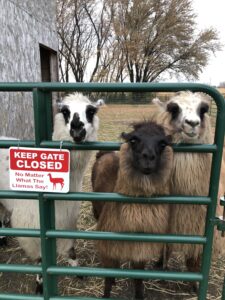| WHO: | Little Curly Pig Farm | ||
| WHAT: | Pig farm | ||
| SIGNATURE PRODUCTS: | Pork and eggs | ||
|
WHERE: CONNECT: |
Norwood Young America, MN |
 Have you ever gone shopping for cattle and came home with pigs instead?
Have you ever gone shopping for cattle and came home with pigs instead?
No?
That was the experience of Michelle Anderson of Hamburg’s Little Curly Pig Farm. “This is the most amazing breed of animal. They are so smart, social, and docile. We handle our pigs from the time they are born. We take great pride in providing them with a good life.”
our pigs from the time they are born. We take great pride in providing them with a good life.”
Tucked off of HWY 212 just west of Norwood Young America, Michelle established an animal oasis populated with talkative chickens, inquisitive llamas, a posse of barn cats, and, of course, her prized pigs. “I love having people out to the farm! Our animals love visitors. It’s so great to have the chance to teach people about this special breed.”
Michelle thought that their little farm would be a great spot to raise Scottish Highland Cattle. Once she met her first pig of the heritage Hungarian Mangalitsa breed, she changed her mind and never looked back. “I have met some of the most amazingly passionate people all over the world who I may not have otherwise connected with because of these pigs. There’s such a need to provide education.”
 These furry pigs (yes, you read that right) are well suited for a Minnesota lifestyle. Their characteristic thick, curly coats of hair give them a slightly sheep-like appearance. The name of the farm, Little Curly Pig, was inspired by this
These furry pigs (yes, you read that right) are well suited for a Minnesota lifestyle. Their characteristic thick, curly coats of hair give them a slightly sheep-like appearance. The name of the farm, Little Curly Pig, was inspired by this beautiful sheep-like coat.
beautiful sheep-like coat.
“It brings me such joy how much people love our pigs!” shared Michelle. “These pigs changed my life. I can’t imagine our farm without them. I love working with happy pigs and happy people. Also—the piglets. Always love the piglets.”
Mangalitsa pigs are prized for their distinctive fat profile. The word Mangalitsa means “hog with a lot of lard”. In contrast with the lean pork of “the other white meat” fame, mature Mangalitsa have a much higher body fat content than conventional pork. Since they grow more slowly, require more room and outside access, and overall have fattier cuts, they went from being a prized breed to nearly going extinct in the 1990s.
Mangalitsa meat is typically reddish and marbled with a creamy white fat. This fat is high in Omega-3 and Omega-6 fatty acids. The lard melts at a lower temperature than other breeds because it contains more unsaturated fat. 
Sometimes referred to as the Kobe beef of pork, Mangalitsa have made a healthy comeback. Its  meat is prized for salamis and other cured meats. Its marbled quality creates a richly flavorful product.
meat is prized for salamis and other cured meats. Its marbled quality creates a richly flavorful product.
The fat itself has a light pink tone. It can be eaten on its own, whipped into creamy spreads like lardo, rendered and used for pastry crusts, and in lieu of other cooking oils. Lardo is a variety of salume made from pork fatback. Michelle currently has a batch of 4-year old lardo from a trial started back in January 2020. Sliced super thin, it is best enjoyed by itself, or served with homemade rye bread from one of her best fat customers.
At Little Curly Pig Farm, all sales are direct from the farm. Michelle offers full and half shares as well as individual cuts. Unique items such as bones, heads, organs, and the fat itself are all available. She also  sells breeding stock and feeder pigs.
sells breeding stock and feeder pigs.
 Purchase pork and eggs by contacting Michelle through her Facebook page or at statefairblue@gmail.com.
Purchase pork and eggs by contacting Michelle through her Facebook page or at statefairblue@gmail.com.
Follow @littlecurlypigfarm on Facebook and Instagram to watch the Mangalitsas make nests out of pine trees or see where the barn cats have burrowed today.
Follow @meettheminnesotamakers on Facebook and Instagram to discover more Minnesota farms and food producers!
Little Curly Pig Farm will be one of the three Minnesota Makers participating in the April 20 Taste Maker class at the Farm at the Arb Minnesota Landscape Arboretum. Class participants will sample Michelle’s pork prepared by Chef Beth Fisher while they learn about this unique heritage breed.





